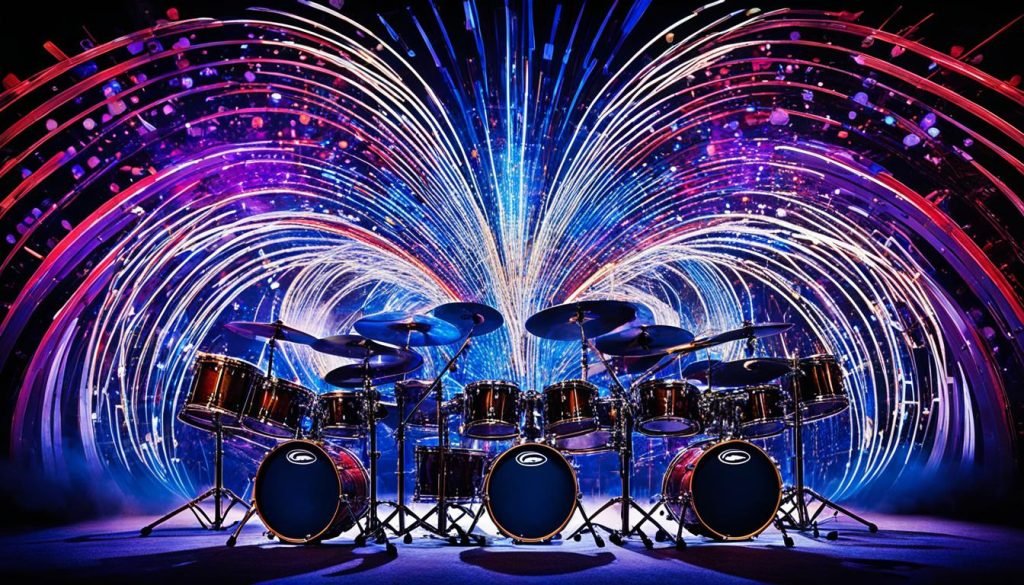Did you know “A Night in Tunisia” by Dizzy Gillespie is very popular? It’s been played over 200 times worldwide. This song mixes Afro-Cuban beats and lively bebop sounds. Trumpets, saxophones, piano, drums, and bass come together in this tune. They create a wonderful sound that people love.
Let’s explore how each instrument adds to the song “A Night in Tunisia.” We’ll see why each part is important for the music.
Key Takeaways
- “A Night in Tunisia” includes trumpet, saxophones, piano, drums, and bass.
- The music blends jazz and Afro-Cuban rhythms.
- Many artists have played this famous song.
- Different versions might have other instruments, but the main ones are always there.
- Each instrument has a special role in making the sound of the piece.
Introduction to A Night in Tunisia
‘A Night in Tunisia’ is not just a jazz song. It’s a creation by Dizzy Gillespie that has become very important in jazz. It was first called ‘Interlude’. Gillespie made it between 1940-1942. It uses bebop and Afro-Cuban jazz styles.
This piece shows how different musical styles can come together. It has stayed popular for many years. Many artists have played it in their own way. Instruments like the trumpet, saxophones, and piano are key to its sound.
To really get ‘A Night in Tunisia’, you need to know about the instruments. The trumpet’s tunes and the drums’ beats are special. Every instrument is important. Together, they make ‘A Night in Tunisia’ a masterpiece in jazz.
Art Blakey and the Jazz Messengers Version
The 1958 release of ‘A Night in Tunisia’ by Art Blakey and his band was a big deal in jazz. Art Blakey was known for his top-notch drumming. He led the band with amazing energy.
This version stood out because of its hard bop style. It blended complex beats and on-the-spot playing perfectly. The group had stars like Bill Hardman and Johnny Griffin. With Sam Dockery on piano and Spanky DeBrest on bass, their sound was rich and famous.
This recording shows how well they played together. It used Night In Tunisia music instruments in an amazing way. Blakey’s drums really pushed the hard bop sound, making this a memorable jazz tune.
| Musician | Instrument |
|---|---|
| Art Blakey | Drums |
| Bill Hardman | Trumpet |
| Johnny Griffin | Tenor Sax |
| Jackie McLean | Alto Sax |
| Sam Dockery | Piano |
| Spanky DeBrest | Bass |
Core Instruments in A Night in Tunisia
‘A Night in Tunisia’ has a beautiful mix of sounds. Its main instruments create a blend that’s both rhythmic and harmonious.
Trumpet
The trumpet shines in ‘A Night in Tunisia’. It leads with melody and complex solos. Its bright and strong tones stand out, bringing a special flair to the music.
Saxophones
Alto and tenor saxophones are key in the song. They add deep harmonies and lively contrasts. The way they work together makes the music richer and full of life.
Piano
The piano sets the song’s harmonic base. It plays chords and rhythms, adding depth. It also takes solo parts, making the music even more interesting.
| Instrument | Role | Contribution to Sound |
|---|---|---|
| Trumpet | Main melodic lines, solos | Bold, brilliant tones |
| Saxophones (Alto & Tenor) | Harmonies, dynamic contrasts | Rich textures, vibrant energy |
| Piano | Chordal support, rhythm | Harmonic depth, complexity |
Drums in A Night in Tunisia
The drums in “A Night in Tunisia” are key to its rhythm. The Night In Tunisia Drum Patterns mix swing with Cuban rhythms. This mix takes the listener on a musical journey. Art Blakey’s drumming on this track is famous. He brings the song to life. The story goes that the rhythm started with a laugh using a trash can.

The drum patterns go beyond typical jazz. They add unique energy to the song. These drum patterns have influenced many jazz drummers. They are a major part of jazz drumming today.
Art Blakey also used special Night In Tunisia Musical Equipment. This added new sounds to the song. Together, the drumming and equipment changed jazz music. They helped make this song very influential.
| Rhythmic Element | Details |
|---|---|
| Swing Integration | Fusion of swing beats with Cuban rhythms. |
| Innovative Equipment | Utilisation of unique instruments and techniques. |
| Performance Style | Art Blakey’s dynamic and robust drumming approach. |
| Influence | Inspiration to jazz drummers across generations. |
Trumpet’s Role in the Jazz Standard
The trumpet is key in ‘A Night in Tunisia,’ often led by Dizzy Gillespie. His skills show how much the trumpet means to jazz. The trumpet shares the main theme and plays complex solos.
The trumpet is vital in creating the bebop feel, full of Afro-Cuban beats. Its clear sound mixes different styles in ‘A Night in Tunisia Jazz.’ The trumpet’s power and expression add fun and depth.
The trumpet really brings out ‘A Night in Tunisia’s’ character. It moves through tricky solos and tunes, making the piece special. Look at how the trumpet stands out among other instruments:
| Instrument | Role | Notable Performer |
|---|---|---|
| Trumpet | Main Theme, Solos | Dizzy Gillespie |
| Saxophone | Harmony, Solos | Charlie Parker |
| Piano | Chords, Rhythm | Bud Powell |
This table shows how important the trumpet is, especially with Dizzy Gillespie. It plays a big part in ‘A Night in Tunisia.’
Saxophones’ Contribution to the Harmony
The saxophones make “A Night In Tunisia” truly stand out. The alto and tenor saxophones blend to give the tune an exotic touch.
They start with an upbeat rhythm. The saxophones layer the background harmonies beautifully. Their perfect fourth intervals highlight the song’s uniqueness.
The alto and tenor saxophones’ interaction is key. They play a half-step higher each time. This creates a tension that grabs everyone’s attention.
The saxophonists hold everything together well. They do more than just back up the melody. They truly lift the whole song.
- The start
- Uplift the exotic flavour of the piece.
- Enhance escalating tension and release.
- Support and elevate the melody.
| Aspect | Alto Saxophone | Tenor Saxophone |
|---|---|---|
| Starting Point | Upbeat of ‘1’ | Upbeat of ‘1’ |
| Harmony | Perfect Fourth Intervals | Perfect Fourth Intervals |
| Pattern | Half-step Higher Each Repetition | Half-step Higher Each Repetition |
The saxophones play a vital role in “A Night In Tunisia Harmonies”. Their expertise and harmony make the song unforgettable.
The Underrated Role of the Bass
In “A Night in Tunisia,” the bass plays a big part. It keeps the song together with its steady groove. It makes sure the beat stays exciting and strong.
Creating the Groove
The bass is key in making “A Night in Tunisia” catchy. Its repeating pattern makes the song move. It keeps the beat even. Spanky DeBrest’s bass makes the rhythm patterns stand out.
Synchronization with Drums
The bass and drums work well together in “A Night in Tunisia.” They form a strong support for the song. This lets other instruments try new things. The Night In Tunisia Rhythm Section is in sync. They make a lively interaction. This makes the groove inviting and deep.
The Role of Piano in A Night in Tunisia
The piano is very important in *A Night in Tunisia*. It gives the music its basic chords. The pianist mixes tune and harmony, keeping the music grounded.
When playing the *Night In Tunisia Chords*, the pianist sets up the tune’s structure. They make a base for soloists to add their bits. The pianist also gets to shine with their own bits.
The piano works well with other instruments. Its chords and rhythms give the tune its unique sound. This balance of support and solo spots makes the music richer.

| Description | Details |
|---|---|
| Harmonic Framework | Provides the underlying chords, essential for structure. |
| Improvisational Role | Alternates between comping and solo improvisations. |
| Interaction with Ensemble | Enhances overall group coherence with rhythmic and chordal support. |
| Contribution to Texture | Adds depth and grounding through chordal stabs and melodic lines. |
The Unique Drum Patterns
“A Night in Tunisia” is known for its special drum beats. These beats mix bebop drumming with Afro-Cuban rhythms. They are complex and creative.
This mix makes a rhythm that catches your ear and heart. It makes Night In Tunisia Drum Rhythms stand out. People love it and remember it because of this.
The music shows great skill and a deep love for jazz. By mixing different rhythms, musicians make the music come alive. This makes it unforgettable for those who hear it.
| Key Aspects | Details |
|---|---|
| Combining Styles | Fusion of bebop and Afro-Cuban rhythms |
| Technical Challenge | Complexity that challenges musicians |
| Aesthetic Appeal | Engaging texture for listeners |
| Legacy | Essential to jazz genre’s evolution |
A Night in Tunisia’s Influence on Later Jazz
‘A Night in Tunisia’ is a key jazz piece. It has greatly changed jazz music. It has especially affected jazz fusion. Its mix of Afro-Cuban beats and bebop tunes has inspired many musicians. They explore new paths in jazz thanks to it.
Impact on Jazz Fusion
The song’s impact on jazz fusion is clear. Jazz fusion blends jazz with rock, funk, and more. Miles Davis and John Coltrane took ideas from ‘A Night in Tunisia’. They used its rhythms and tunes in their music. This mix has made jazz more vibrant and varied.
Notable Covers and Artists
Many artists have covered ‘A Night in Tunisia’. This shows its lasting appeal and versatility. Stars like McCoy Tyner, Dizzy Gillespie, and Art Blakey have added their touch to it. Their versions have made this song even more loved. They have also brought it to new listeners, keeping it alive in jazz.
The legacy of ‘A Night in Tunisia’ shows its lasting charm. It’s a major piece in jazz’s growth. Its effect on jazz fusion and many covers prove this. It keeps touching musicians and fans all over the world.
What Instruments Are In A Night In Tunisia?
‘A Night in Tunisia’ uses lots of cool instruments. The core instruments are the trumpet, saxophones, piano, drums, and bass. They all add something special to make this jazz song amazing.
The trumpet kicks things off with excitement, thanks to great players like Dizzy Gillespie. Saxophones make the tune richer with their sounds. The piano keeps the beat and adds beautiful chords.
The drums make lively beats that are fun to listen to. The bass makes sure everything fits together perfectly. This mix lets every player show their skills. It also shows how working together makes something awesome.
| Instrument | Role |
|---|---|
| Trumpet | Main melody, virtuosic solos |
| Saxophones | Harmonic counterpoint, melodic embellishments |
| Piano | Rhythmic and harmonic foundation |
| Drums | Complex rhythmic patterns, drive |
| Bass | Groove creation, harmonic support |
Together, these core instruments make a song that’s loved a lot in jazz. It shows off the brilliant skills of the musicians.
Conclusion
We have come to the end of our journey through ‘A Night in Tunisia.’ This iconic jazz piece has made a big impact. Its drum patterns and the roles of trumpet and saxophone create a timeless tune, loved for decades.
‘A Night in Tunisia’ is not just music; it’s a cultural piece that connects bebop with Afro-Cuban jazz. It shows the genre’s creativity. Legends like Dizzy Gillespie and Art Blakey have played it, keeping its true spirit alive.
This jazz standard influences many music types and motivates artists all over. Its melodies and rhythms are both beautiful and complex. ‘A Night in Tunisia’ is truly special in music history, its magic undying.







